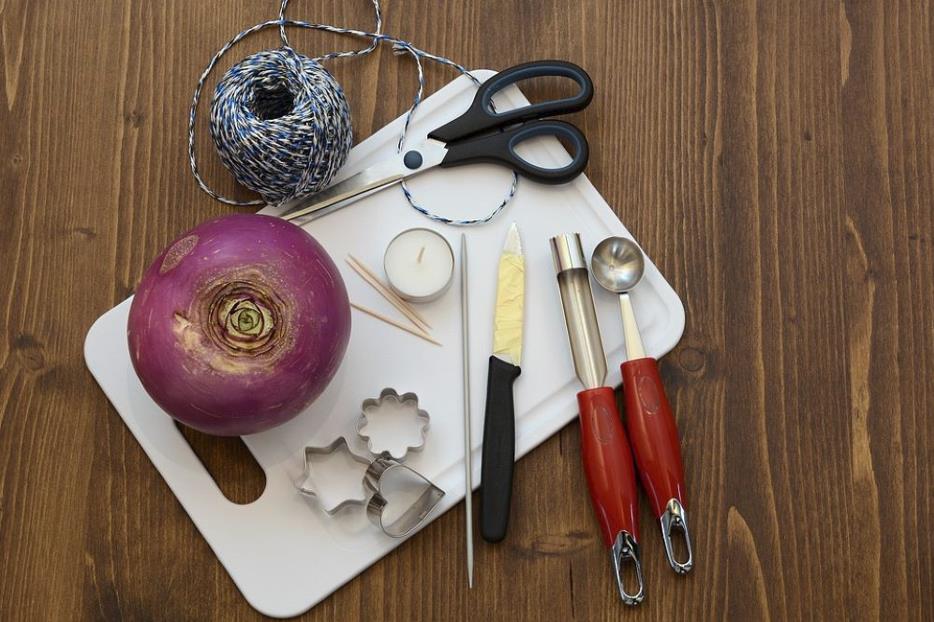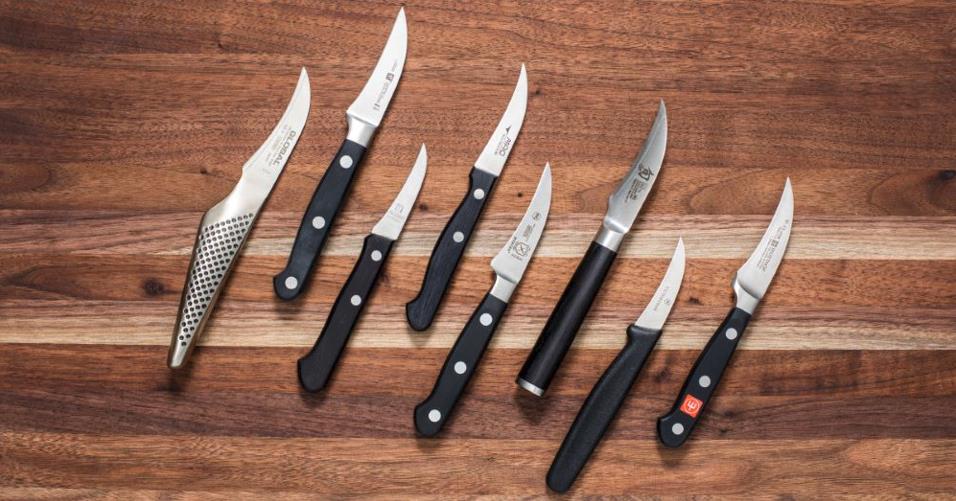Let’s face it: most of our knives mounted beautifully on magnetic strips, knife blocks, or similar knife storage solutions end up being largely for aesthetics. In reality, we only end up using one or two due to limited knowledge on when and how to use them.
Among these lucky few are two common knives known as the utility knife and the paring knife. This time, we bring you the ultimate utility knife vs. paring knife showdown so that you can slice perfect cuts with the right knife each time you embark on your culinary adventures.
The utility knife, featuring a blade length between 4 to 7 inches, is a true all-rounder knife ideal for nearly all kitchen tasks. The paring knife, however, is shorter with a 3-4 inches blade. It is perfect for intricate tasks such as peeling, de-seeding, de-veining, as well as cutting herbs and vegetables.
Table of contents
What is a paring knife?

The paring knife is a specialty knife named after its role. The word paring largely implies cutting away ends or any outer surface.
The paring knife is a short and sturdy kitchen tool featuring a blade length between 3-4 inches.
Its small and sturdy design, as well as ergonomic handle, allows for intricate and precise cutting, dicing, and peeling tasks. This is because they are lightweight and easy to hold which allows for easy control and intricate cuts. Moreover, they are the perfect tools for de-seeding fruits, deveining shrimps, coring, and other similar tasks.
This knife can handle fruits, vegetables, herbs, fish, and even meat (small pieces only).
How to use a paring knife

A paring knife is used mostly for peeling fruits and vegetables. However, slicing, coring, de-seeding and deveining are some other tasks that the knife is ideal for. Here is a simple how-to for using a paring knife:
- Begin with a sharp paring knife and wrap your fingers around the blade.
- Position your thumb on the fruit, vegetable, or whatever ingredient you wish to use your knife on.
- Allow your index finger to touch the paring knife blade for added control.
- Bring the face of the knife towards you and grab the fruit or vegetable with your free hand.
- For peeling, press the knife blade against the fruit/vegetable and push the blade towards you as you peel.
- For deveining shrimp, make a shallow cut on the shrimp for exposing the vein and remove it with a knife tip.
Pros and cons
- Paring knives allow for making intricate cuts and precision work. Due to their compact design, they can make their way even through tight corners.
- A small knife is not capable of bigger tasks such as handling meat or tough fruits and vegetables.
- They are too small to be handled comfortably.
Variations of the paring knife

There are a number of variations found in the paring knife. These are the bird’s beak, spear point tip, sheep’s foot and the Japanese Western-style paring blade. Find out the differences so that you can choose one that best suits your needs:
Bird’s beak
The bird’s beak is a shorter version of the paring knife with a blade length in between 2-3 inches. As the name implies, the bird beak has a concave-shaped razor-sharp blade that makes it ideal for intricate slicing work.
Even though these blades provide precision, they are hard to sharpen with an electric sharpener and you may require sharpening it often all the more. However, it is easier to sharpen the knife with a whetstone.
Also, a good quality bird beak will save you the trouble of a dull blade.
Spearpoint tip
The spear point tip is the classic version of the paring knife with a blade length between 3-4 inches.
The blade of a spear point tip is smooth and outward, allowing less effort to be exerted by the chef.
Often, they come with a serrated blade edge that makes slicing tasks a breeze.
Sheep’s foot
The sheep’s foot is a paring knife that comes with a straight blade and a rounded tip. This allows the tip of the blade to firmly touch the food for cutting whilst allowing the length of the blade to completely contact the cutting board.
The sheep’s foot allows intricate, quick work with less chance of error.
Cheese cutting and juliennes are easier with the sheep’s foot.
Japanese paring blade-western style
There is another version of the paring knife that is similar to a bird’s beak blade, only straighter. This is often regarded as a fusion of western and Japanese-style knives. The blade is comparatively sharper and harder. However, the straight blade only allows for lifting motions.
What is a utility knife?
A utility knife lies somewhere between a chefs’ knife, boning knife, and paring knife, featuring a blade of length anywhere between 4-7 inches.
You might wonder what the point of this knife is since a chef knife exists for handling large ingredients and paring knives handle all the small ones. Well, who’s going to take care of the medium-sized ingredients? The utility knife, of course.
When a chef’s knife seems too big to handle an ingredient, the utility knife comes in to save the day. Easier to handle and use than the chef knife, it is more preferable by a number of chefs around the world.
True to its name, it serves to be an all-rounder in the kitchen that can slice most ingredients including meat, vegetables, fruits, etc.
Handpicked for you
True cutting power in the palm of your hand
How to use a utility knife

- Hold the utility knife with your dominant hand.
- Place the ingredient to be cut on the cutting board.
- Begin cutting, slicing, dicing, etc. as required.
Here are some of the ways you can use a utility knife:
- Chopping fruits and vegetables
- Slicing poultry and meat
- Slicing bread, buns, etc.
- Cutting steak, cheese, sandwiches, etc.
Pros and cons
- The utility knife is best if you don’t own a large number of knives and are looking for a kitchen tool that performs a maximum number of general kitchen tasks.
- However, the utility knife cannot handle larger ingredients that a chef’s knife does.
- It is only suitable for cutting and slicing medium-sized ingredients.
Variations
Standard utility knife
This is the classic version of the utility knife that you’ll find on most kitchens. The standard utility knife features a blade that is slightly curved. The blade makes it easier for the user to use gentle rocking motions when slicing.
The blade also comes scalloped which means that food tears can conveniently be prevented when using this knife. The standard utility knife is the number one go-to option for chefs in the kitchen.
Serrated utility knife
As evident from its name, the serrated utility knife comes with a serrated blade edge. Other than that, it is the same as the standard utility knife.
The serrated blade is best for ingredients that have hard exteriors yet interiors that are soft. Slicing bread is a whole new experience with a serrated utility knife. This is why these knives are also known as sandwich knives.
Pocket knives
The last variation in utility knives is the one that exists for use outside of the kitchen. These utility knives are also known as pocket knives and provide ease in slicing cardboard boxes, Styrofoam, paper, and similar items.
These knives feature a number of different blades that you can choose according to your preference and requirements.
Utility knife vs. paring knife
| Feature | Paring knife | Utility knife |
| Blade length | 3-4 inches | 4-7 inches |
| Blade profile | Short and narrow blade | Medium length, narrow blade |
| Size | Smaller than a paring knife | Bigger than a paring knife and smaller than a chef’s knife |
| Handle | ErgonomicFlat or straight | ErgonomicFlat or straightSerrated or straight edge |
| Usage | Precise cutting tasks, de-seeding, de-veining, slicing and peeling | General kitchen tasks |
| Best for | Fruits and vegetables | Fruit, vegetables and meat |
| Variations | Standard, Bird’s Beak, Sheep’s Foot | Straight-edged or serrated |
Which knife to buy?
Now that you have learned the difference between a utility knife and a paring knife, you might be wondering which one to buy. Utility knife? Paring knife? Or both?
If you’re looking for a minimalist kitchen at the moment you should buy a utility knife. This is because the knife is an all-rounder and can perform almost all general kitchen tasks. This includes tasks a paring knife can handle such as peeling and coring etc.
However, buying both will allow your kitchen tasks to become easier as now you know when to use which kitchen knife. Also, paring knives will get you places no other knife can take you!
Both of these knives will prove to be handy kitchen tools that will allow you to cook with ease. Our verdict is therefore to buy both: utility knife and the paring knife.
We hope you can now make an informed choice on your knives selection. Happy knife shopping!












